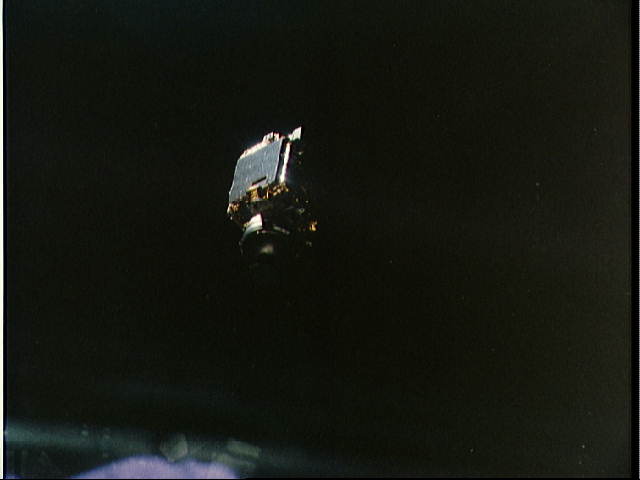|
GSAT-18
GSAT-18 is an Indian communications satellite. Built by ISRO and operated by INSAT, it carries 24 C-band, 12 extended C-band, and 12 Ku-band transponders. The satellite was launched on 5 October 2016 at approximately 20:30 UTC aboard an Ariane 5 ECA rocket from the Guiana Space Centre in Kourou, French Guiana. The launch vehicle inserted the satellite into a geosynchronous transfer orbit, and once in service it will occupy the orbital slot at 74° East longitude. The total cost of the satellite and launch services was about . GSAT-18 was originally scheduled to launch on 12 July 2016 alongside Japan's Superbird-8 satellite, but a shipping mishap which damaged Superbird-8 forced a delay in the launch schedule. Arianespace later paired GSAT-18 with Australia's Sky Muster II for a 4 October 2016 launch. The launch was delayed 24 hours to 5 October due to excessively high crosswind A crosswind is any wind that has a perpendicular component to the line or direction of trave ... [...More Info...] [...Related Items...] OR: [Wikipedia] [Google] [Baidu] |
INSAT
The Indian National Satellite System or INSAT, is a series of multipurpose geostationary satellites launched by ISRO to satisfy the telecommunications, broadcasting, meteorology, and search and rescue operations. Commissioned in 1983, INSAT is the largest domestic communication system in the Indo-Pacific Region. It is a joint venture of the Department of Space, Department of Telecommunications, India Meteorological Department, All India Radio and Doordarshan. The overall coordination and management of INSAT system rests with the Secretary-level INSAT Coordination Committee. INSAT satellites provide transponders in various bands to serve the television and communication needs of India. Some of the satellites also have the Very High Resolution Radiometer (VHRR), CCD cameras for meteorological imaging. The satellites also incorporate transponder(s) for receiving distress alert signals for search and rescue missions in the South Asian and Indian Ocean Region, as ISRO is a m ... [...More Info...] [...Related Items...] OR: [Wikipedia] [Google] [Baidu] |
Indian National Satellite System
The Indian National Satellite System or INSAT, is a series of multipurpose geostationary satellites launched by ISRO to satisfy the telecommunications, broadcasting, meteorology, and search and rescue operations. Commissioned in 1983, INSAT is the largest domestic communication system in the Indo-Pacific Region. It is a joint venture of the Department of Space, Department of Telecommunications, India Meteorological Department, All India Radio and Doordarshan. The overall coordination and management of INSAT system rests with the Secretary-level INSAT Coordination Committee. INSAT satellites provide transponders in various bands to serve the television and communication needs of India. Some of the satellites also have the Very High Resolution Radiometer (VHRR), CCD cameras for meteorological imaging. The satellites also incorporate transponder(s) for receiving distress alert signals for search and rescue missions in the South Asian and Indian Ocean Region, as ISRO is a m ... [...More Info...] [...Related Items...] OR: [Wikipedia] [Google] [Baidu] |
GSAT
The GSAT (Geosynchronous Satellite) satellites are India's indigenously developed communications satellites, used for digital audio, data and video broadcasting. As of 5 December 2018, 20 GSAT satellites of ISRO The Indian Space Research Organisation (ISRO; ) is the national space agency of India, headquartered in Bengaluru. It operates under the Department of Space (DOS) which is directly overseen by the Prime Minister of India, while the Chairman o ... have been launched out of which 14 satellites are in service. History The GSAT series of geosynchronous satellites is a system developed by ISRO with an objective to make India self-reliant in broadcasting services. The repertoire of 10 GSAT satellites, a total of 168 transponders (out of which 95 transponders are leased out to provide services to the broadcasters) in the C, Extended C and Ku-bands provides services to telecommunications, television broadcasting, weather forecasting, disaster warning and search and rescue ... [...More Info...] [...Related Items...] OR: [Wikipedia] [Google] [Baidu] |
GSAT Satellites
The GSAT (Geosynchronous Satellite) satellites are India's indigenously developed communications satellites, used for digital audio, data and video broadcasting. As of 5 December 2018, 20 GSAT satellites of ISRO The Indian Space Research Organisation (ISRO; ) is the national space agency of India, headquartered in Bengaluru. It operates under the Department of Space (DOS) which is directly overseen by the Prime Minister of India, while the Chairman o ... have been launched out of which 14 satellites are in service. History The GSAT series of geosynchronous satellites is a system developed by ISRO with an objective to make India self-reliant in broadcasting services. The repertoire of 10 GSAT satellites, a total of 168 transponders (out of which 95 transponders are leased out to provide services to the broadcasters) in the C, Extended C and Ku-bands provides services to telecommunications, television broadcasting, weather forecasting, disaster warning and search and rescue ... [...More Info...] [...Related Items...] OR: [Wikipedia] [Google] [Baidu] |
GSAT-9
The South Asia Satellite (designated GSAT-9), formerly known as SAARC Satellite, is a geostationary communications and meteorology satellite operated by the Indian Space Research Organisation for the South Asian Association for Regional Cooperation (SAARC) region. The satellite was launched on 5 May 2017. During the 18th SAARC summit held in Nepal in 2014, Indian Prime Minister Narendra Modi mooted the idea of a satellite serving the needs of SAARC member nations as a part of his neighbourhood first policy. Afghanistan, Bangladesh, Bhutan, Maldives, Nepal and Sri Lanka are the users of the multi-dimensional facilities provided by the satellite. Pakistan "offered technical and monetary support" which India rejected saying that it wanted the project to be a "gift" and multi-national collaboration would be time-consuming. Pakistan later on declined to participate in the project citing India's refusal to collaboration and security reasons. Afghanistan too was initially non-committal ... [...More Info...] [...Related Items...] OR: [Wikipedia] [Google] [Baidu] |
I-3K
I-3K or the INSAT 3000 is a satellite bus developed by Indian Space Research Organisation (ISRO), and marketed by Antrix Corporation and New Space India Ltd. It is the standard bus for 3,000-kg class satellites; the 'I' in I-3K stands for INSAT, a group of communication satellites developed and launched by ISRO. The I-3K bus can supply DC power up to 6500 watts, and is suitable for satellites with lift-off mass in range of 3,000-3,400 kg. List of satellites launched using I-3K bus * Eutelsat W2M (Now Afghansat 1) * INSAT series ( 4A 4B) * GSAT series ( 8 10 16 15 18 19 17 24 29 30) See also * Comparison of satellite buses This page includes a list of satellite buses, of which multiple similar artificial satellites have been, or are being, built to the same model of structural frame, propulsion, spacecraft power and intra-spacecraft communication. Only commercially ... References External links I-3K ISRO brochure Indian Space Research Organis ... [...More Info...] [...Related Items...] OR: [Wikipedia] [Google] [Baidu] |
Ariane 5 ECA
Ariane 5 is a European heavy-lift space launch vehicle developed and operated by Arianespace for the European Space Agency (ESA). It is launched from the Centre Spatial Guyanais (CSG) in French Guiana. It has been used to deliver payloads into geostationary transfer orbit (GTO) or low Earth orbit (LEO). The launch vehicle had a streak of 82 consecutive successful launches between 9 April 2003 and 12 December 2017. Since 2014, Ariane 6, a direct successor system, is in development. The system was designed as an expendable launch system by the '' Centre national d'études spatiales'' (CNES), the French government's space agency, in cooperation with various European partners. Despite not being a direct derivative of its predecessor launch vehicle program, it is classified as part of the Ariane rocket family. ArianeGroup is the prime contractor for the manufacturing of the vehicles, leading a multi-country consortium of other European contractors. Ariane 5 was originally intended ... [...More Info...] [...Related Items...] OR: [Wikipedia] [Google] [Baidu] |
ELA-3
ELA-3 (french: Ensemble de Lancement Ariane 3, lit=Ariane Launch Complex 3), is a launch pad and associated facilities at the Centre Spatial Guyanais in French Guiana. ELA-3 is operated by Arianespace as part of the expendable launch system for Ariane 5 Ariane 5 is a European heavy-lift space launch vehicle developed and operated by Arianespace for the European Space Agency (ESA). It is launched from the Centre Spatial Guyanais (CSG) in French Guiana. It has been used to deliver payloads in ... launch vehicles. , 114 launches have been carried out from it, the first of which occurred on 4 June 1996. ELA-3 is 21 square kilometres in size. Launch history Scheduled flights References {{Ariane Guiana Space Centre ... [...More Info...] [...Related Items...] OR: [Wikipedia] [Google] [Baidu] |
GSAT-15
GSAT-15 is an Indian communication satellite similar to GSAT-10 to augment the capacity of transponders to provide more bandwidth for Direct-to-Home television and VSAT services. It was successfully launched on 10 November 2015 at 21:34:07 UTC aboard an Ariane 5 rocket, along with the ArabSat 6B satellite. Payload The satellite carries 24 Ku band transponders and a GAGAN navigational payload operating in the L1 and L5 bands. Besides that it will also carry 2 Ku band beacons. Satellite GSAT-15 has an estimated lifespan of 12 years. It will augment telecommunication, Direct-to-Home and radio navigation services. Cost Cost of launch and insurance: about . See also * Indian Regional Navigation Satellite System * Global Navigation Satellite System * Global Positioning System The Global Positioning System (GPS), originally Navstar GPS, is a satellite-based radionavigation system owned by the United States government and operated by the United States Space Force ... [...More Info...] [...Related Items...] OR: [Wikipedia] [Google] [Baidu] |
Crosswind
A crosswind is any wind that has a perpendicular component to the line or direction of travel. This affects the aerodynamics of many forms of transport. Moving non-parallel to the wind's direction creates a crosswind component on the object and thus increasing the apparent wind on the object; such use of cross wind travel is used to advantage by sailing craft, kiteboarding craft, power kiting, etc. On the other side, crosswind moves the path of vehicles sideways and can be a hazard. Definition When winds are not parallel to or directly with/against the line of travel, the wind is said to have a crosswind ''component''; that is, the force can be separated into two vector components: * the headwind or tailwind component in the direction of motion, * the crosswind component perpendicular to the former. A vehicle behaves as though it is directly experiencing a lateral effect of the magnitude of the crosswind component only. The crosswind component is computed by multiplying the wi ... [...More Info...] [...Related Items...] OR: [Wikipedia] [Google] [Baidu] |
Sky Muster II
The Sky Muster satellites are two geostationary (GEO) communications satellites operated by NBN Co Limited and built by SSL. They were launched in 2015 and 2016 to provide fast broadband in areas where NBN didn't want to either lay fiber or install enough wireless antennas and offshore. They provide download speeds of up to 25 Mbit/s, and upload speeds of 5 Mbit/s in a best-case scenario. Each Sky Muster has 101 spot beams, which are focused satellite signals which are specially concentrated in power and cover a specific geographic area. The electromagnetic Ka band spot beams are used to carry information from the end users' equipment on the ground to the satellites. Each satellite offers 80 gigabits per second of bandwidth. The two satellites will provide high-speed broadband service to 400,000 Australian homes and businesses in rural and remote Australia. The two satellites were designed to provide service for at least 15 years. Sky Muster I (NBN-Co 1A) was launched on 1 ... [...More Info...] [...Related Items...] OR: [Wikipedia] [Google] [Baidu] |



